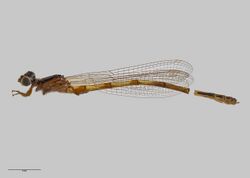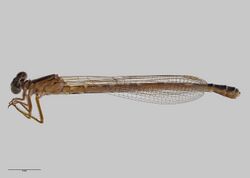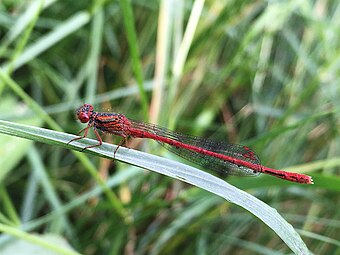Biology:Xanthocnemis zealandica
| Xanthocnemis zealandica | |
|---|---|

| |
| Male holotype specimen held at the Auckland War Memorial Museum. | |

| |
| Female allotype specimen held at the Auckland War Memorial Museum. | |
| Scientific classification | |
| Domain: | Eukaryota |
| Kingdom: | Animalia |
| Phylum: | Arthropoda |
| Class: | Insecta |
| Order: | Odonata |
| Suborder: | Zygoptera |
| Family: | Coenagrionidae |
| Genus: | Xanthocnemis |
| Species: | X. zealandica
|
| Binomial name | |
| Xanthocnemis zealandica (McLachlan, 1873)
| |
| Synonyms | |
| |
Xanthocnemis zealandica, commonly known as common redcoat damselfly,[1] red damselfly, or red coat damselfly, is one of the most common native New Zealand damselflies.[2] Adult damselflies are often seen flying around vegetation close to streams.
Taxonomy
This species was first described by Robert McLachlan in 1873 and named Telebasis zealandica.[3] Until 1981, it was the only species in the endemic New Zealand genus Xanthocnemis.[4][5]
Description
The larvae of the red damselfly are identified by their pointed tail gills and long hairs by the tip.[6]
Ecology
This species is endemic to New Zealand and is widespread and common on North, South and Stewart Islands.[7][8]
X. zealandica larvae are widespread across New Zealand, occurring in rocky and weedy streams and ponds.[6] It is predominantly a low-altitude species but can reach 1,945 m (6,381 ft) above sea level.[1]
X. zealanica has been classified by the Department of Conservation as "Not threatened".[9]
Behaviour
X. zealandica has a 2–3 year life cycle; the shorter one was observed near sea level while the longer one was characteristic to a mid-elevation site (579 m (1,900 ft) above sea level). Some individuals at the lowland site may even complete their life cycle in one year.[10]
Adults are most active at high air temperatures and they are not active when the temperature of the air falls below 14°C.[11] Mature females deposit one egg at a time, just below water level, whereas mature males patrol these areas and sometimes form swarming groups.[11]
X. zealandica individuals can become infested by larval water mites in the genus Arrenurus.[12] Infected damselflies may have up to 62 mites, but there was no evidence that the mating behaviour of infested male damselflies was affected.[12]
Gallery
References
- ↑ 1.0 1.1 1.2 Rowe, R. (2020). "Xanthocnemis zealandica". IUCN Red List of Threatened Species 2020: e.T197094A83372380. doi:10.2305/IUCN.UK.2020-1.RLTS.T197094A83372380.en. https://www.iucnredlist.org/species/197094/83372380. Retrieved 4 October 2021.
- ↑ "Fast versus slow: differing life history strategies of two New Zealand damselfly (Odonata: Zygoptera) species" (in en). https://www.wikidata.org/wiki/Q112936103.
- ↑ McLachlan, Robert (1873). "A Catalogue of the Neuropterous Insects of New Zealand ; With Notes, and Descriptions of new Forms.". The Annals and Magazine of Natural History; Zoology, Botany, and Geology 12: 30–42. https://www.biodiversitylibrary.org/page/19214096.
- ↑ Rowe, Richard J. (1981-01-01). "A New Species of Xanthocnemis Tillyard (Odonata: Coenagrionidae) from the Chatham Islands, New Zealand" (in English). Records of the Auckland Institute and Museum 18: 205–209. https://www.wikidata.org/wiki/Q58677180.
- ↑ Rowe, Richard J. (1985-01-01). A taxonomic revision of the genus Xanthocnemis (Odonata: Coenagrionidae) and an investigation of the larval behaviour of Xanthocnemis zealandica (Thesis). UC Research Repository.
- ↑ 6.0 6.1 "Red damselfly (Coenagrionidae: Xanthocnemis)". Landcare Research. http://www.landcareresearch.co.nz/research/biocons/freshwater/details.asp?Freshwater_Spp_Species_ID=28.
- ↑ "Xanthocnemis zealandica (McLachlan, 1873)". https://biotanz.landcareresearch.co.nz/scientific-names/89bf828f-7690-4c2b-b3a2-17461e2ab5c3.
- ↑ "Fast versus slow: differing life history strategies of two New Zealand damselfly (Odonata: Zygoptera) species" (in en). https://www.wikidata.org/wiki/Q112936103.
- ↑ , Wikidata Q76413677
- ↑ Deacon, K.J. (1979). The Seasonality of four Odonata species from mid Canterbury, South Island, New Zealand (PDF) (Ph.D. thesis). Canterbury University.
- ↑ 11.0 11.1 Crumpton, W. J. (1975-01-01). "Adult behaviour of Xanthocnemis zealandica McLachlan and Austrolestes colensonis White at selected South Island (N. Zealand) habitats (Zygoptera: Coenagrionidae, Lestidae)" (in English). Odonatologica 4 (3): 149–168. https://www.wikidata.org/wiki/Q89678655.
- ↑ 12.0 12.1 Mckee, Dermot; Harvey, Ian; Thomas, Matt; Sherratt, Tom N. (2003-01-01). "Mite infestation of Xanthocnemis zealandica in a Christchurch pond". New Zealand Journal of Zoology 30 (1): 17–20. doi:10.1080/03014223.2003.9518320. https://www.wikidata.org/wiki/Q124283926.
External links
- Xanthocnemis zealandica discussed on RNZ Critter of the Week, 22 December 2023
Wikidata ☰ Q8042995 entry
 |





